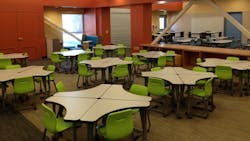Gone are the days of desks and chairs with the teacher standing in front of the classroom. Today’s classroom must have the flexibility to accommodate different learning objectives. “It’s all about getting up and moving around, working with someone, working in a group, and working alone,” says Tricia McDermott, of Peter Gisolfi Associates.
Learning, Unchained
That required flexibility translates into furniture that is not only mobile, but that can also be moved around by students of all ages. Practically, this means castors, according to Director of Interior Design, Carrie Malatesta, of SHP Leading Design. Desks, chairs, and tables on wheels may seem like a potential hazard, particularly in the K-12 sector. However, Malatesta says the versatility allows teachers to reconfigure based on what they are teaching.
For example, a classroom might be seated at a Harkness table working on a group project, which forces students to look at each other and respect what the other students are saying, fostering collaborative learning, says McDermott. But that same table can be pulled apart to accommodate smaller group interactions and even individual work and testing.
Teacher’s stations are changing too. Traditionally, the teacher sat behind a large desk in the front of the classroom. But more teachers are using laptops, affording mobility and flexibility, says McDermott. As such, there has been a trend to abandon desks in favor of svelte lecterns, often on castors so that they can accompany teachers around the classroom or even from one classroom to another. The lectern becomes a personal item, replacing the desk or even an entire classroom as the teacher’s base of operations.
Another traditional component of the classroom is the blackboard, or more recently, the whiteboard. But even that hallmark is no longer the classroom anchor that it once was. Most teachers still want whiteboards in their classrooms, but that doesn’t mean they need to be affixed to the walls. “These boards allow students to work in small groups and brainstorm while they are working,” says Jenny Gallow a designer at SHP Leading Design, noting that manufacturers are now designing whiteboard-surfaced tables. This yields a desk that students can write on to solve math problems or demonstrate theoretical work.
Some schools are incorporating translucent glass walls, allowing anything written upon them to be viewed from both sides while preventing direct views into the room. This expands the traditional board space. So while a teacher may have one primary white board that is used for instruction, students can use these glass surfaces to discuss problems and show each other how to solve them.
Left to Their Own Devices
While most industry insiders agree that flexibility has been the greatest driving trend in school furniture over the past few decades, the impact of technology has been almost as significant. Take ergonomics, for example. When choosing a chair for a college campus, it’s a given that a student may be sitting in the chair for a number of hours during a lecture, necessitating a certain degree of comfort and support. But today’s student will also almost certainly be slouched in the chair using a tablet, phone, or laptop, raising a new set of ergonomic considerations.
Similarly, in the K-12 arena desks and tables must accommodate laptops and tablets. This has spawned the appearance of tables with pullouts for student laptops and desks with pockets for inactive tablets.
An interesting byproduct of new technology like Wi-Fi, laptops, and tablets is that schools find that they suddenly have more space. There is no longer a designated space for a “computer lab” or classroom terminals, as students access material in the cloud using their own or school-issued devices. In the K-12 sector multimedia rooms with extra space are filled with tables and stools to create smaller work stations for students.
“We find that schools are using stools because the students cannot lean back on them. They have to lean in and it forces them to engage,” says McDermott.
Meanwhile, college and university students want comfortable, somewhat isolated areas to engage with technology. “We are finding that there is a demand for couches with high-backs and high wing-backed chairs that have the ability to create a separate space within an open-space,” says Malatesta.
Advances in Wi-Fi and cloud computing have deemphasized the need for Ethernet connections, but Malatesta says students and faculty still need juice to feed their devices. A common solution in higher education is desks and tables with built in AC and USB ports. But K-12 may require more creative solutions, particularly where flexibility and security are concerns. In these settings custom installations may allow charging while minimizing the risk of theft or improper use.
